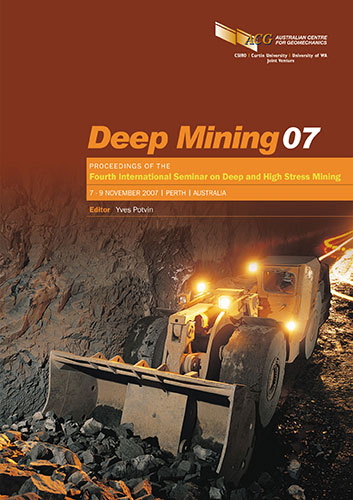Development of a Methodology for Analysis of Instability in Room and Pillar Mines

|
Authors: Board, M; Damjanac, B; Pierce, M |
DOI https://doi.org/10.36487/ACG_repo/711_20
Cite As:
Board, M, Damjanac, B & Pierce, M 2007, 'Development of a Methodology for Analysis of Instability in Room and Pillar Mines', in Y Potvin (ed.), Deep Mining 2007: Proceedings of the Fourth International Seminar on Deep and High Stress Mining, Australian Centre for Geomechanics, Perth, pp. 273-282, https://doi.org/10.36487/ACG_repo/711_20
Abstract:
Since 1994, a number of major roof falls and panel collapses have occurred in room and pillar trona mines within the Green River Basin of Wyoming, USA. Trona is a relatively strong and brittle evaporite mineral that occurs in a flat-lying, 3 m (approximate) thick bed at about 490 m depth. The floor of the seam is composed of thinly-bedded, weak shale and the roof materials of interbedded shales, marlstones, mudstones and sandstones. The largest of these events, a 5.2 Richter magnitude event, occurred at the Solvay Mine in February, 1995. This event, induced by the collapse of the 1 SW panel (over 2 km2 area), occurred in roughly 5 seconds with a simultaneous surface subsidence of approximately 1 m. This paper describes a methodology for estimating the potential for major panel collapses developed through back-analysis of several collapse incidents. The method is similar to the “ground reaction curve” approach for ground support design, and involves separate analysis of the stress-strain response of the primary mechanical components of the system: a) the pillar/floor system for a particular pillar design and extraction ratio, and, b) the overlying roof strata for given panel widths and barrier pillar dimensions. The stress-strain response of the pillar/floor system for a given panel geometry is estimated through back- analysis of instrumented case studies and observations of pillar/floor punching. The stiffness and yield response of the overburden is estimated numerically by replacing the panel pillars with an equivalent back- pressure, and then incrementally removing the pressure to allow closure of the seam. The pressure- displacement response of the two components are superimposed to determine whether an equilibrium state can be achieved, and to estimate the potential violence of the failure response if equilibrium cannot be achieved. Back-analysis of the collapse of three panels at one mine is shown. The method allows rapid analysis of the impacts of adjusting panel extraction ratio, panel span and inter-panel barrier pillar dimensions on global stability, and thus provides a reasonably-simple design analysis tool.
References:
Fugro, Inc. (1997) Numerical analysis of trona-mining induced subsidence known sodium lease area, Green River,
Wyoming. Prepared for Joint Oil/Gas & Trona Industry Development Group, Green River, Wyoming, Rept. No.
0201-3069.
Hoek, E. (1998) Rock engineering course notes, University of Toronto, Ontario, Canada.
Pariseau, W.G. and Eitani, A. (1976) Laboratory rock properties: Alchem Mine. University of Utah, Rept. to Allied
Chemical Corp., October.
Pechmann, J.C., Walter, W.R., Nava, S.J. and Arabasz, W.J. (1995) The February 3, 1995, ML 5.1 Seismic event in the
trona mining district of Southwestern Wyoming, 66 Seismol. Res. Letters 25.
Terra Tek, Inc. (1996) Physical and Mechanical Properties Characterization of OGT COEX 2, Sweetwater County,
Wyoming. Prepared for the Joint Industry OGT Research Project, Rept. No. TR97-06.
Extr. Ratio
(%)
90
85
80
75
25
20
15
10
5
0
0 0.1 0.2 0.3 0.4
A
ve
ra
ge
Pi
lla
rS
tr
es
s
(M
Pa
)
Roof Displacement (m)
Development of a Methodology for Analysis of Instability in Room and Pillar Mines M. Board, et al.
282 Deep Mining 07, Perth, Australia
© Copyright 2026, Australian Centre for Geomechanics (ACG), The University of Western Australia. All rights reserved.
View copyright/legal information
Please direct any queries or error reports to repository-acg@uwa.edu.au
View copyright/legal information
Please direct any queries or error reports to repository-acg@uwa.edu.au